Volume I, Issue 1 | November 2024
Welcome to our first Climate and Equity Newsletter! In this first issue, we hope you’ll
- be interested to hear from colleagues
- be intrigued by a few suggested resources, and
- be inspired to send your own news, reflections, and resources
- suggestions and review (deadline for the next issue: Nov 15th)
Share this newsletter with colleagues, students, and friends — and tell us how it could be more useful for you!
Updates from Climate and Equity Fellows

Ohio: From Drought to Deluge all in a Day—Making place-based Connections
by Claire Monk (’24)
What are the qualities that characterize effective climate and equity education? This was the guiding question of our climate change conversation this past summer. Collectively, we determined that teaching core science concepts with real-time data and analysis and place-based connections are a priority in the classroom.
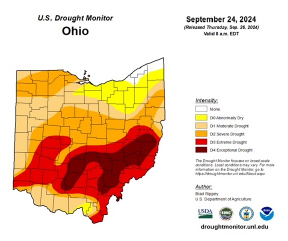
Place-based climate connections definitely resonated with me here in Ohio this weekend! Just last week, 22 counties in Ohio were classified a state of emergency due to severe or exceptional drought conditions. According to local weather persons, Ohio experienced the driest summer on record since 1887!
The effects from the drought are evident with significant agricultural and hydrological impacts, crop failures, dying lawns, scorched leaves, and a dull fall foliage.

Within days of the state of emergency declaration comes Hurricane Helene and the deluge that follows the drought. This past weekend wreaked havoc here, with 50 mph wind gusts, downed trees, power outages, and severe flooding. This is a picture of our front yard, and the old oak branches, leaves and acorns that fell during the height of the weekend weather.
Curriculum Connections
So, as the heavy rains pounded my window panes over the weekend, a thought occurred to me. This is a perfect storm for cross-curricular climate connections in Chemistry!!!! Hurricane Helene is a prime example of rapid intensification of storm systems! “She” was a tropical storm just 48 hours before making landfall on Florida’s Gulf Coast as a Category 4 hurricane. The fact that Helene intensified so rapidly got me thinking about specific heat capacity, warming mid-Atlantic waters and the direct impact on our weekend weather in Ohio.
Check out this rainfall forecast from Friday!
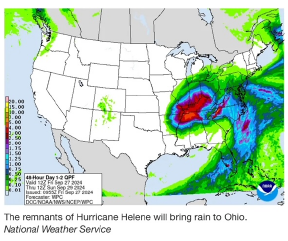
Sadly, this drought to deluge weather weirding is not really news here in Ohio. It is our new normal and the makings for a great place-based climate connection.
According to the New York Times, global sea surface temperatures have broken temperature records every day for more than a year. The Mid-Atlantic is warmer than ever, which is fuel for more intense storm systems like Hurricane Helene. As you are all aware, there is a direct correlation between sea surface temperatures and our atmosphere. According to NOAA, Summer 2024 was the hottest on record. In August alone, average land and sea surface temperatures were 2.29°F (1.27°C) above the 20th century average.
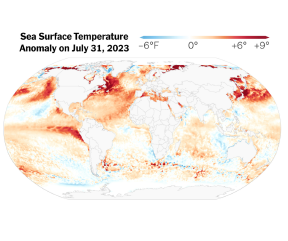
Which in a long evidence-based way, brings me to my climate curriculum connection. In Chemistry, we just started our heat, temperature and phase unit. Hurricane Helene is a real-world example of heat energy transfer between the atmosphere and the oceans. This energy transfer causes phase change, increasing evaporation rates, fueling increased storm intensity. Based on the limited hurricane research I have done this weekend, it is unknown if the frequency of Mid-Atlantic storm systems is directly correlated to climate change. That being said, there is substantial evidence that suggests these storms are intensifying due to more rapid heat transfer and warming seas.
In Chemistry, I will make this climate curriculum connection by comparing heat energy transfer between the atmosphere and oceans with real-time data and energy diagrams. Students will also learn how to explain these big energy changes on a particle level, as particle collisions relate to energy transfer and in this case, a phase change. Using heat equations, students can then calculate the amount of energy required (heat of vaporization) to evaporate large amounts of water! In doing so, students will then be able to make real and relevant connections between heat energy, land and water temperatures, and storm systems. These calculations are always eye-opening for students considering water has a very high specific heat capacity and requires substantially more heat energy to change temperature let alone phase! Through all of the data and analysis above, I believe effective climate change connections will be place-based, in real time AND in Chemistry! Climate change is and should be INTERDISCIPLINARY!
TERC Climate Project
Speaking of interdisciplinary … as for my TERC project progress, I am currently working on a curriculum map for my new Honors Climate Change course. I am happy to share learning targets, unit outlines and resources. The course will be interdisciplinary, with the first unit focusing on thermodynamics (physics, chemistry) and energy transfer within the Earth system. The second unit (geology) will investigate natural forcing agents, the Earth system and geologic time. The third unit will be focused on anthropogenic/unnatural forcing agents, fossil fuels and the Industrial Revolution (humanities). The fourth unit is a deep dive into national and international policy, real world connections and the realities of a warming world (geography, government and current events). Lastly, the fifth unit is focused on mitigation, adaptation and hope (problem solving, engineering). For our TERC Project, Oisín and I collaborated on an alternative energy lesson plan that will align well with the learning targets in this last unit! Big thanks Bess for sending a wind and solar lab kit our way! Definitely planning on a few engineering activities focused on alternative energies to round out the course. Since the Honors Climate Change course won’t run until Fall 2025, this year is dedicated to curriculum development.
As always, my curriculum is a work in progress. Hoping all are well and the school year is off to a most excellent start!
Claire Monk

Reflections on the Institute and its impact on you: Looking back on the 2022 Institute by Tanya Flores
I’m the sort of teacher who is constantly reaching out for new opportunities. My father is a great scientist, and there’s nothing I would like to do more than to inspire students to enter the field. This is why I applied for the Climate and Equity Institute. I was thrilled to be chosen, yet wondered if I would learn much because I’ve already studied climate change extensively. I definitely had no idea what an illuminating experience I was in for.
Here are some notes from my personal Journal entries written that week.
7/18/22 This is not the regular P.D. I had assumed it would be, more like a think tank? Today I learned there’s a term for that need to kick off shoes and walk along a dirt path, it’s called “earthing” (L. Haupt). I learned about a book, All We Can Save, ordered it, and can’t wait to teach from it when I get home.
7/19/22 Surprising day. Saturated, pummeled, and whelmed with learning and realization. Finding so much common ground with other attendees. The beginning of Susanne Moser’s depressing workshop on our trauma experiences with climate change. Reverand Mariama Hammond’s talk about how our true hope is the coming generation that we’re teaching right now. Starting to feel Maine-ified. Heavy morning mist giving way to a clear blue sky, the sound of the waves and a green waft of foamy fauna sea spray. Our societies are based on exploitation, and this is a time of generational dissonance (Reverand Mariama). This is a remarkable experience! The group leaders, Brian, Gilly, and Shadé, are all being vulnerable, relating their human-ness.
7/20/22 Who ever knew? I’m travelling in my heart and soul. Embracing the enormity, rising to the momentous call to action. In modern times the most powerful people spend hardly minutes a day in the outside world, Megan Bang said we live in boxes. Concept right!? How has this changed our relationship to nature? 80% of the Earth’s Biodiversity exists on first people’s land. We need first people, yes the same ones we’ve been eradicating for millennia, to lead us from this destruction, to lead us with ancient knowing. Ironic?
7/21/22 I feel absolutely blessed to be here. Crazy good. Best ever P.D., really! Another full day and I’m woke. Awoken to lichen, moss, blueberries and red spruce. We walked to the cliff at night and lay listening to crashing waves beneath an enveloping blanket of celestial sparks. I walked 12,900 steps today.
7/22/22 It feels so good to be a part of something, to be ready to turn this experience, this chaotic swirl of insight, into ripples and action, I have become a part of this vast movement for healing and restoration. Earth warriors from very different parts of the walks of life, with so much in common.
Now it’s 2024, several years along this inspired Maine moon-beam. These two years I’ve enjoyed a fantastic collaboration with remarkable educators I met in Maine. The experience has inspired and informed my teaching practice. I did know a lot about the urgency and the surrounding issues, but before Maine, I felt paralyzed and alone. I am better now, infused with the agency that the Maine experience inspired.

Resources Recommended
Check these resources out, mentioned at our recent call-back meeting! Share a resource you’re using, and give us a sentence or two about it!
Sean Tracy (’24) mentioned using the PBL Lesson Generator in his work this year. He writes “The Lesson Generator tool was developed by the UPENN Grad School of Education to help teachers create Project Based Learning experiences. You can give it an idea or a role that you want your students to take on and it will help generate ideas. It can also help you write student directions and assessment tools.”
Sara Young (’22) recommended Project Ice, a summer program from the American Meterological Society, focusing on paleoclimatology, ice core science, and climate change.
From their website: Project Ice is a comprehensive teacher professional development course based on studies of the Earth’s climate system with emphasis on ice cores. It is directed towards improving teacher effectiveness in generating interest and understanding in science, technology, engineering, and mathematics among pre-college students. Now accepting applications for summer 2025.
Sarah Grigg (’22) shared ideas about vertical gardens, based on materials from the Coastal Maine Botanical Garden: Vertical Gardens.
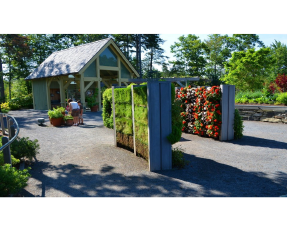
- The walls are custom built out of cedar with shelves supporting the boxes.
- The boxes are made out of lobster crate wire measuring 8D”x 12L”. These are lined with landscape filter fabric and filled with potting soil, compost and two tablespoons of organic pelletized fertilizer.
- The Potting Soil: 20% Peat, 5% Vermiculite, 5% Perlite and 30% Bark, 10% Coir and 25% Compost (Leaf Mold, Kitchen Waste, Manure, Grass Clippings). We do use peat-free potting media that consists more of compost, bark, coir, rice or barley hulls depending on the crops. In General, this grade of potting soil is more coarse than average Pro-mix blend. The compost conditions soil for optimal moisture retention and nutrient absorption. The boxes that are planted with succulents have an added succulent planting mix to mimic their traditional soil conditions. Additional organic granular fertilizer is added to provide slow release fertility.
- 1″ plant plugs are planted with the boxes lain down for 2-3 weeks until the roots have grown enough to stabilize the soil from pouring out.
- Once they are placed vertically, a drip irrigation line atop each box emits water 15-20 mins a day.
- Traditionally, these walls are taken care of by the participants in the Horticultural Therapy program that occurs in this space.
If you have any more questions, please e-mail our Horticultural Therapist, Irene Barber, ibarber@mainegardens.org. Thank you and enjoy the gardens.

News Notes
An update from Ronnie Vesnaver (’22)
Ronnie is now working for a non-profit called the Upstream Alliance (link here); she is Director of Regional Programs & Partnerships. You might enjoy this excerpt from her bio on the Alliance’s “Team” page:
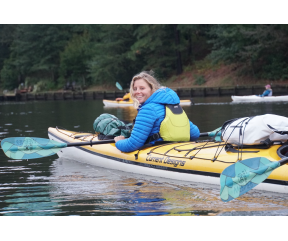
Ronnie is passionate about the history and environment of waterways. That passion has steered her toward a career in education and conservation, which has allowed her to share the history and environments she loves with others. After graduating from Colby College, Ronnie taught at the Pennington School in New Jersey. While there, Ronnie earned a masters in Environmental History at Rutgers University focusing her research on coastal and ocean history. Ronnie spent summers working on the schooner Mystic Whaler and is an alum of the Williams-Mystic maritime studies program. In 2020, Ronnie moved to the Eastern Shore of Maryland to join the Gunston School where she taught humanities for, and later directed, the Chesapeake Watershed Semester, a place-based experiential semester program. On the weekends you can catch Ronnie running, doing yoga, paddling, driving the Eastern Shore, or walking countless miles with her black lab, Archie. Email: ronnie@upstreamalliance.org
Now’s your chance! Deadline for next newsletter
Send us your ideas, your news items, or resource reviews by Nov. 15th, for the newsletter to appear after Thanksgiving.
Call-backs: Feel free to suggest topics for future call back sessions
Contact Brian at climateandequity@terc.edu with ideas and proposals!
The Climate and Equity project is funded by the John D. and Catherine T. MacArthur Foundation.
